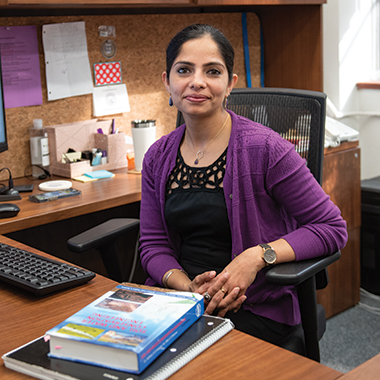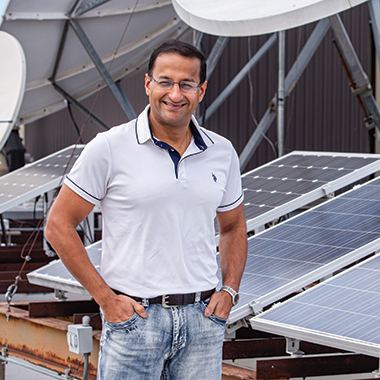Sustainability starts with research
By Grant Guggisberg
Sustainability is an important aspect of nearly everything happening within the Carl R. Ice College of Engineering. More than just a buzzword, the word sustainable appears in the college’s mission statement and the design, building and operation of sustainable infrastructure is one of the college’s top research strengths.
Joining with partners who are prioritizing sustainable systems, faculty continue to produce cutting-edge ideas and push the envelope of what is possible with engineering ingenuity.
Two projects headline what has been a strong year for research within the college, which has secured $31.2 million in funding for projects, many of which are working to develop a sustainable future. Both projects are funded through Established Program to Stimulate Competitive Research, or EPSCoR, grants from the National Science Foundation, which aim to build collaborative interdisciplinary teams with complementary expertise and resources.
Sharda developing spray-on bioplastics
 Vaishali Sharda, assistant professor in the Carl and Melinda Helwig Department of Biological and Agricultural Engineering at Kansas State University, received a nearly $6 million grant to develop spray-on bioplastics that protect soil and control weeds in an environmentally friendly way.
Vaishali Sharda, assistant professor in the Carl and Melinda Helwig Department of Biological and Agricultural Engineering at Kansas State University, received a nearly $6 million grant to develop spray-on bioplastics that protect soil and control weeds in an environmentally friendly way.
“Creating a protective layer over soil when growing field crops could help farmers better manage
many issues at once.”— Vaishali Sharda
Sharda is directing the four-year collaborative project, “Bioplastics with Regenerative Agricultural Properties,” or BioWRAP, alongside three co-principal investigators from K-State and researchers from the University of Nebraska- Lincoln and the South Dakota School of Mines. Joining her from K-State are Ajay Sharda, associate professor of biological and agricultural engineering; Pascal Hitzler, professor of computer science; and Katherine Nelson, assistant professor of geography and geospatial sciences.
The project aims to reduce the use of plastics, herbicides and associated environmental impacts in agricultural production by creating an all-in-one bioplastic system that can better manage weeds, nutrients, soils and water resources.
“Creating a protective layer over soil when growing field crops could help farmers better manage many issues at once,” Sharda said. “Covering soil with sheet plastic prevents weed growth, erosion and moisture loss, but using large amounts plastic creates waste, is not eco-friendly, and is too costly for field crops.
“New, locally sourced types of bioplastics that fully break down into safe by-products can be made. These new materials could provide farmers with a green way to control weeds, fertilize crops, protect soil and water resources, and work with nature to better manage their fields.”
The envisioned product will be a spray-on biodegradable plastic that can be administered to row crop production systems. Three types of biopolymers will be tested: Polyhydroxyalkanoate (PHA)-based, protein-based and hybrid polymers. The product would be locally produced from plant and animal proteins like corn stover and chicken feathers and infused with nutrients and microbes that will add to soil health as the covering degrades.
Natarajan leading K-State portion of $24 million project
Ensuring that infrastructure is equipped to support all communities after a disaster, including historically underserved groups that often receive less aid in the aftermath, is the aim of a five-year, $24 million statewide initiative.
K-State joins a collaborative group of 16 other universities and colleges in Kansas, along with industry leaders and disaster experts, for the project, which is designed to better equip communities with limited resources before and after a natural disaster strikes. The project is titled “Adaptive and Resilient Infrastructures Driven by Social Equity.”
 Bala Natarajan, Steve Hsu Keystone research scholar and Clair N. Palmer and Sara M. Palmer electrical engineering professor in the Mike Wiegers Department of Electrical and Computer Engineering, is leading K-State’s portion of the project and all of the research.
Bala Natarajan, Steve Hsu Keystone research scholar and Clair N. Palmer and Sara M. Palmer electrical engineering professor in the Mike Wiegers Department of Electrical and Computer Engineering, is leading K-State’s portion of the project and all of the research.
“I find that the most challenging societal problems typically require solutions that cut across disciplinary boundaries,” Natarajan said. “That is why I am excited to work on this unique project, as it brings together a diverse team of researchers from across Kansas to help create a paradigm shift in resilience science and engineering.”
The project’s overall goal is to determine how infrastructure resilience intersects with social equity and how human capacity, physical infrastructure and policy levers can be designed to achieve socially equitable outcomes that collectively improve decisions and community resilience. The NSF will provide $20 million, with the state of Kansas adding $4 million in matching funds.
“I find that the most challenging societal problems typically require solutions that cut across disciplinary boundaries."
— Bala Natarajan
Belinda Sturm at the University of Kansas will serve as principal investigator on the project. Joining Natarajan from the Carl R. Ice College of Engineering at K-State as co-principal investigators are George Amariucai and Lior Shamir, both from computer science; Husain Aziz, civil engineering; Anil Pahwa, electrical and computer engineering; and Vaishali Sharda, biological and agricultural engineering. Jason Bergtold, agricultural economics, joins from the College of Agriculture.
“The team will leverage fundamental advances and tools from social sciences, engineering and computer sciences to develop a new social equity-driven paradigm that will transform the way researchers and communities approach smart and resilient communities,” Natarajan said. “Working closely with multiple stakeholders, we are looking forward to translating our theoretical modeling and analysis work into a meaningful decision support framework that Kansas communities can use in their policymaking, planning and operation of critical infrastructures.”
Targeting underserved populations, the project will introduce more than 2,400 Kansas families to resilience, resulting in an understanding of individual capacity and preparedness for disasters while providing pipelines to higher education.